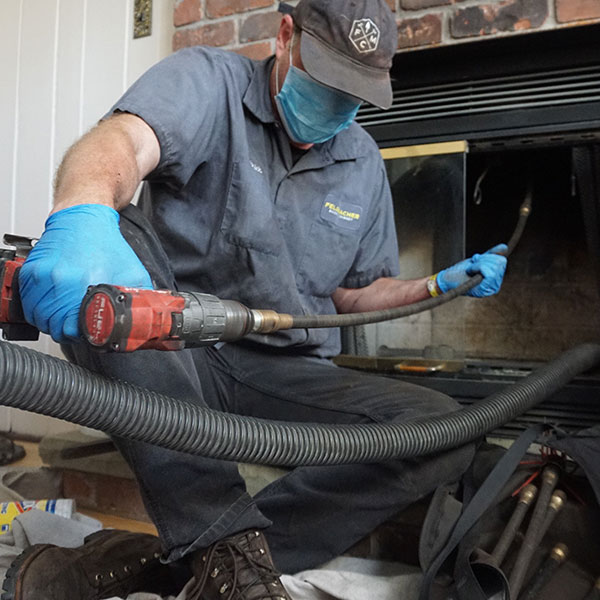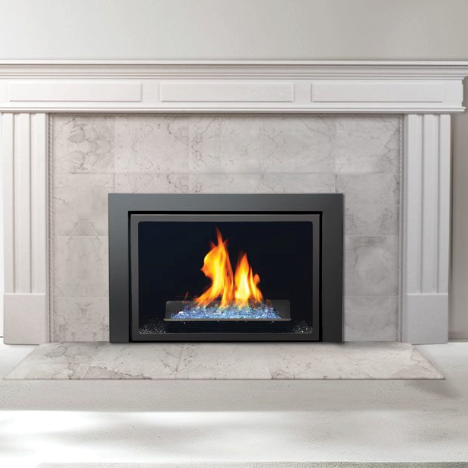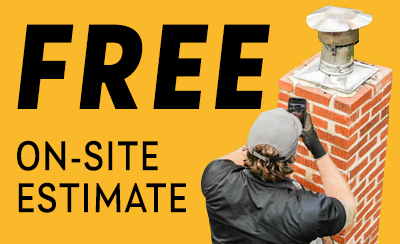FAQs About Chimney & Fireplaces for Your Home
Do you have a burning question about fireplaces or chimneys? We have compiled this list of frequently asked questions for you! We hope you find the answer you’re looking for, whether you need advice about maintaining an existing fireplace or what to expect from a new fireplace.
If you don’t find an answer on this page, take advantage of our chat box or give us to call to get answers from an expert!
 How often should a wood-burning fireplace be cleaned?
How often should a wood-burning fireplace be cleaned?
Throughout the burning season, you should be regularly disposing of ashes. A general rule is to clean out ash once it reaches the grate. You can leave about an inch of ashes along the bottom to help your fires burn more efficiently.
When you remove ashes:
- Be sure to wait at least 12 hours after your last fire.
- Use a metal shovel for live embers and remove ash.
- Always extinguish any live embers that you find.
- Place the ashes in a metal container and store them away from combustible materials for another 3 to 5 days before disposal. (This precaution is necessary since there may be live embers you didn’t see left in the ashes. You could accidentally ignite your trash or lawn if you throw out the ashes immediately. This is also why you should never use a regular vacuum to remove ashes.)
Once you are ready to close your fireplace for the year, remove all the ashes and clean the firebox with soapy water. Leaving ashes in your fireplace during the spring and summer can aggravate your respiratory system and allergies.
How often should the chimney be cleaned?
Wood-Burning Fireplace
If you have a wood-burning fireplace, the chimney should be professionally cleaned and inspected at least once a year. Homeowners who use their fireplace frequently may need additional cleanings. Along with an annual inspection and cleaning, fire safety experts recommend an extra chimney sweep after burning a cord of firewood. (A cord is 128 cubic feet of firewood or a 4-foot high and 8-foot deep stack of wood.) Otherwise, dangerous amounts of creosote–a highly flammable byproduct of burning wood–may accumulate in your chimney during the winter.
Gas Fireplace
If you have a gas fireplace, you don’t have to worry about chimney cleanings. BUT fire safety experts recommend a professional inspection at least once a year. While gas fireplaces produce minimal smoke and no creosote, an annual inspection is a wise investment to prevent the risk of carbon monoxide poisoning or a house fire from a malfunctioning component or obstructed ventilation system.
When is the best time to schedule a chimney sweep or chimney inspection?
Autumn is the peak season for chimney sweeps. Many homeowners wait until cold weather sets in or a problem arises to contact a chimney professional. As a result, you may end up on a waiting list if you delay your chimney inspection and cleaning until the fall.
Spring is the best season to schedule a chimney inspection and cleaning. It is the off-peak season which means you can often take advantage of discounted services and convenient scheduling times. In addition, clearing creosote out of the chimney before the summer heat will prevent it from stinking up your home or aggravating your allergies. Finally, if any damage or deterioration is discovered during the inspection, you will have ample time for repairs before the next burning season.
Do I need to schedule an annual chimney inspection if I don’t use my fireplace?
Yes! Even if you don’t use your fireplace, the chimney can become clogged or damaged from critters, lawn debris, and severe weather. In addition, chimney masonry can deteriorate due to wear ‘n tear from rain, sleet, and snow.
Chimney leaks are an example of a common problem that homeowners with a fireplace experience, regardless of whether they use it or not. Many homeowners’ insurance policies require proof of an annual chimney inspection before they will fulfill a claim for chimney-related damages including water damage from a chimney leak.
If you haven’t used your fireplace in years, it is especially important to have it inspected before lighting a fire. You could spark a chimney fire or suffer carbon monoxide poisoning if there is a problem in your fireplace you are unaware of.
What is a fireplace insert?
A fireplace insert transforms a traditional fireplace into a powerful heating appliance without sacrificing the ambiance of a roaring fire. It’s a pre-made firebox that is installed inside an existing fireplace. Fireplace inserts were designed to improve heat output and energy efficiency.
The heat efficiency of traditional masonry fireplaces ranges from 10 to 20% (meaning 80 to 90% of the heat generated by a fire is lost up the chimney!). Fireplace inserts solve this problem. With a gas or wood insert, your fireplace’s heat efficiency can be 70% or higher!
What fuel does a gas fireplace or fireplace insert burn?
You can choose to power your gas fireplace or fireplace insert with natural gas or propane. The best fuel option depends on what is available in your area.
 Can I use my gas fireplace when the power is out?
Can I use my gas fireplace when the power is out?
Yes, depending on what type of gas fireplace or insert you have. Many are designed with a backup battery or millivolt ignition so that they can operate even when the power is out. Check your owner’s manual or ask an expert to find out if your gas fireplace or gas insert will work when the power is out.
We hope that you’ve found answers to your fireplace or chimney questions. However, if you still have questions, don’t hesitate to ask our team at Felgemacher Fireplace Shop! We’re happy to share our knowledge about fireplace inserts, log sets, stoves, and more. Our CSIA-certified chimney techs can help troubleshoot fireplace or chimney problems. We serve residents throughout the Rochester, NY, and Buffalo, NY and regions in-between.



